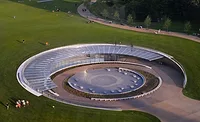Petersen Metal Panels Integral in LEED Gold Fire Station
After literally two decades in the planning, the new Iowa City Fire Station No. 4 is complete and providing improved service to the northeast section of the city. Located on a high-visibility site, the LEED Gold facility establishes a prominent visual presence for the fire department in the center of the service area.
The 11,300-square-foot facility is comprised of two distinct elements: the apparatus bay and the service/living area. The apparatus bay features a drive-through design, which is very popular among firefighters when possible.
Environmental impact and sustainability were at the forefront of the design, from the selection of materials and systems to the arrangement of the building. Architectural design for the project was provided by Rohrbach Associates PC of Iowa City.
Approximately 18,000 square feet of PAC-CLAD material in three different profiles were utilized to meet design objectives. The project included 13,815 square feet of 24-gauge Tite-Loc Curved, Tapered and Straight Panels; 2,520 square feet of .032 aluminum PAC-750 Soffit Panels; and 1,600 square feet of PAC-3000 AP Aluminum Plate Panels.
“We had planned on a metal roof and wall panels since the early stages of the design,” Project Architect Will Downing said. “Metal provided design flexibility for the roofs and walls, plus good durability and economy. Our office uses metal on a regular basis, because of its inherent capabilities and visual appeal.”
The installation of all roof and wall panels was done by Modern Builders Inc. of Janesville, Iowa. The Tite-Loc Panels used to roof the apparatus bay were curved on-site. “We do a lot of work with Petersen,” said Patrick Buckingham, architectural draftsman, who oversaw the project. “Their people are easy to work with and very responsive.”
The PAC-3000 AP Wall Panels were used to link the various levels of the roof. They were installed last to assure that joints lined up properly. “The aluminum plate panels were an upgrade instead of using a thinner sheet material as originally planned,” Downing said.
The greatest design challenge, according to Downing, was adapting the concept to the site. “In order to lessen the impact of the facility on the adjacent protected slope and natural land shared with neighboring residential lots, the east wall of the apparatus bay is engaged into the hill to serve as part of the retaining wall structure,” he said. “The lower service/living area is placed in front of the taller apparatus bay to provide a more gradual vertical appearance.”
The fire station is expected to play a role in promoting development in the area. “The city and the fire department both wanted a ‘stand-out’ design to be seen by people as they enter from the northeast,” Downing said. “The new station definitely provides a nice anchor for the community.”
For more information, visit www.pac-clad.com.
Looking for a reprint of this article?
From high-res PDFs to custom plaques, order your copy today!



